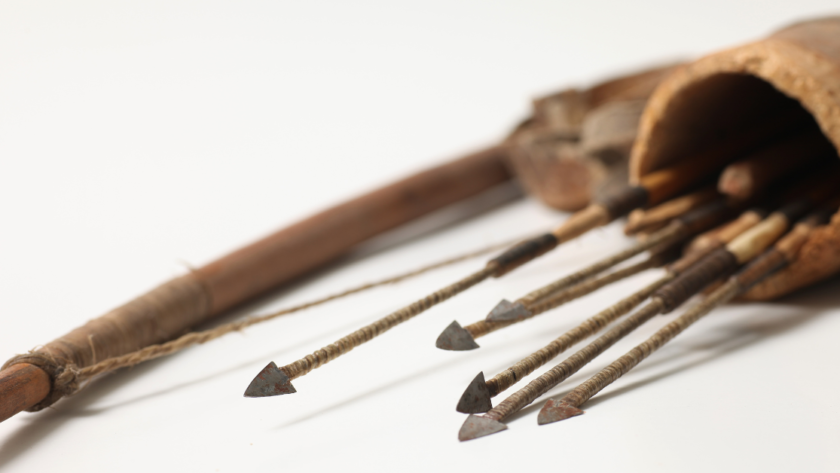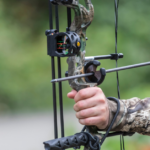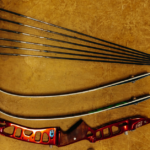As an avid archer, I’ve experienced the frustration of watching arrows veer off course because of damaged fletchings or bent shafts. It’s enough to make anyone consider trading their bow for knitting needles.
But don’t hang up your quiver just yet!
I’m here to share the arrow repair secrets that have saved my sanity and my wallet over the years.
Whether you’re a weekend warrior or a competitive archer, knowing how to breathe new life into your arrows is an invaluable skill.
With the rising costs of archery equipment, learning to repair your arrows is both satisfying and economical.
Understanding Arrow Anatomy: The Foundation of Effective Repairs
Before we start wielding fletching jigs and arrow straighteners, it’s crucial to understand the components of an arrow.
Each part plays a vital role in the arrow’s flight, and knowing how they work together will make you a more effective arrow doctor.
An arrow typically consists of:
- Shaft: The main body of the arrow, usually made of aluminum, carbon fiber, or wood.
- Nock: The plastic insert at the rear of the arrow that clips onto the bowstring.
- Fletching: The vanes or feathers near the nock that stabilize the arrow in flight.
- Insert: A small piece inside the front of the shaft that allows for the attachment of different points.
- Point: The business end of the arrow, which can be a field point, target point, or broadhead.
Understanding these components and how they interact is key to effective arrow repair. For example, changing the weight of your point can affect the arrow’s spine (stiffness).
This knowledge becomes crucial when you’re replacing components and trying to maintain consistent arrow performance.
Fletching Repair: Resurrecting Feathers and Vanes
Let’s start with the most common repair: fletching replacement. I can’t count the number of times I’ve retrieved an arrow from a target only to find a vane hanging by a thread.
It’s a sight that can make even the most stoic archer shed a tear.
To replace fletching, you’ll need:
- A fletching jig
- Replacement vanes or feathers
- Fletching adhesive
- Isopropyl alcohol for cleaning
Here’s the step-by-step process:
- Remove any remnants of the old fletching and clean the shaft thoroughly with alcohol. This step is crucial for proper adhesion.
- Set up your fletching jig according to the manufacturer’s instructions. This tool confirms consistent placement of your vanes or feathers.
- Apply a thin line of adhesive to the base of the vane or feather, then carefully place it in the jig.
- Close the clamp and let it set for the recommended time.
- Repeat this process for the remaining vanes, ensuring proper spacing and alignment.
Pro Tip: When replacing fletching, consider experimenting with different vane sizes or helical configurations to fine-tune your arrow’s flight characteristics. This can be particularly useful when transitioning between target archery and hunting, or when fine-tuning your setup for different distances.
Shaft Straightening: Bringing Your Arrows Back in Line
A bent arrow shaft is every archer’s nightmare. But before you toss that crooked arrow in the trash, let’s see if we can salvage it.
For aluminum arrows, you can use an arrow straightener tool. This device allows you to apply controlled pressure to bend the shaft back into alignment.
It takes practice and patience, but it’s a skill worth mastering.
Carbon arrows are trickier. Minor bends can sometimes be corrected by heating the shaft with a hair dryer and carefully straightening it.
However, be warned: carbon arrows with significant damage should be retired for safety reasons.
A fractured carbon shaft can splinter upon release, potentially causing injury.
When straightening arrows, always check for hairline cracks or other damage that might compromise the arrow’s integrity. Safety should always be your top priority.
Nock Repair and Replacement: Ensuring a Solid Connection
A damaged or misaligned nock can wreak havoc on your accuracy. Fortunately, nock replacement is a relatively simple repair that can breathe new life into an otherwise good arrow.
To replace a nock:
- Remove the old nock by gently twisting and pulling it out of the shaft.
- Clean the inside of the shaft with a cotton swab and alcohol.
- Apply a small amount of nock adhesive to the new nock.
- Insert the nock, aligning it with the cock vane (the odd-colored vane).
- Allow the adhesive to set according to the manufacturer’s instructions.
When replacing nocks, pay attention to the nock’s throat size. This should match your bowstring’s serving diameter for a proper fit.
A nock that’s too tight or too loose can affect your shot consistency and potentially damage your bowstring.
Insert and Point Replacement: Fine-Tuning Your Arrow’s Front End
Replacing inserts and points allows you to customize your arrows for different applications. This can be particularly useful when transitioning between target archery and hunting, or when fine-tuning your setup for different distances.
To replace an insert:
- Heat the front of the arrow with a hair dryer to soften the existing adhesive.
- Carefully remove the old insert and clean out any remaining adhesive.
- Apply hot-melt adhesive to the new insert.
- Quickly insert it into the shaft, ensuring it’s fully seated and aligned.
When choosing new points or broadheads, consider how the weight will affect your arrow’s Front-of-Center (FOC) balance and spine. A heavier point will increase FOC and effectively weaken the spine, which may need adjustments to your bow tuning.
Arrow Spine Testing: Ensuring Consistency Across Your Set
After making repairs, it’s crucial to check your arrows’ spine consistency. Spine refers to the arrow’s stiffness and how much it flexes when shot.
Inconsistent spine across your arrow set can lead to frustrating accuracy issues.
You can test spine consistency using a spine tester tool or by using the “frequency method”:
- Suspend the arrow horizontally by it’s ends.
- Gently tap the middle of the shaft.
- Listen to the tone it produces.
Arrows with consistent spine will produce the same tone. Any outliers may need further attention or might need to be set aside for practice use only.
Adapting Repair Techniques for Different Arrow Types
The repair techniques we’ve discussed can be adapted for various arrow types, but each material has it’s quirks:
- Wood arrows need special care when applying adhesives and may need different straightening techniques.
- Aluminum arrows are more forgiving when it comes to straightening but can be prone to bending again if not properly reinforced.
- Carbon arrows are incredibly durable but need careful inspection for invisible damage that could lead to catastrophic failure.
Always research specific techniques for your arrow type and never hesitate to retire an arrow if you’re unsure about it’s safety.
Advanced Arrow Repair Techniques
Cresting and Custom Wraps
Cresting involves painting decorative bands around the arrow shaft. This adds a personal touch but can also help with arrow identification. Custom wraps serve a similar purpose and can be applied more easily.
To apply custom wraps:
- Clean the shaft thoroughly with alcohol.
- Carefully align the wrap on the shaft.
- Slowly roll the arrow, smoothing out any bubbles as you go.
- Trim any excess material at the edges.
Refurbishing Wooden Arrows
Wooden arrows need special care. To refurbish a wooden arrow:
- Gently sand the shaft to remove any rough spots or splinters.
- Apply a thin coat of boiled linseed oil to protect the wood.
- Re-seal the grain at the ends of the shaft with super glue.
- Replace the nock and fletching as needed.
Carbon Arrow Repair Limitations
While many repairs are possible with carbon arrows, it’s important to know their limitations. Any carbon arrow with visible cracks, splits, or severe bends should be immediately retired. The risk of a catastrophic failure upon release is simply too high.
Creating an Arrow Repair Kit
Having a well-stocked arrow repair kit can save you time and frustration, especially when you’re at the range or in the field. Here’s what I recommend including in your kit:
- Fletching jig and adhesive
- Spare nocks and nock adhesive
- Arrow straightener (for aluminum arrows)
- Isopropyl alcohol and cotton swabs
- Small scissors or a sharp knife
- Sandpaper (various grits)
- Hot melt glue and a lighter
- Spare inserts and field points
- Arrow lube (for easier target removal)
With this kit, you’ll be prepared to handle most common arrow repairs on the spot.
Preventative Maintenance: Extending Arrow Life
An ounce of prevention is worth a pound of cure, and this certainly applies to arrow care. Here are some tips to keep your arrows in top shape:
- Regular Inspection: Before each shooting session, visually inspect your arrows for any damage or wear.
- Proper Storage: Store arrows in a quiver or arrow tube to protect them from bending or damage.
- Rotate Your Arrows: Don’t always shoot the same arrows. Rotate through your set to distribute wear evenly.
- Clean Your Arrows: After shooting, wipe down your arrows with a clean cloth to remove dirt and debris.
- Use Arrow Lube: Applying arrow lube before shooting into foam targets can make removal easier and reduce wear on your fletching.
- Mind Your Draw Length: Shooting arrows that are too short for your draw length can lead to dry fires and damaged arrows.
By following these preventative measures, you can significantly extend the life of your arrows and reduce the need for repairs.
The Environmental Impact of Arrow Repair
As archers, we have a responsibility to be good stewards of the environment. Repairing arrows instead of discarding them reduces waste and lessens our impact on the planet.
Additionally, when you do need to retire an arrow, consider these eco-friendly disposal options:
- Remove usable components (nocks, inserts, points) for future repairs.
- For carbon arrows, check with local recycling centers for proper disposal methods.
- Aluminum arrows can often be recycled with other aluminum products.
- Wooden arrows can be composted if all non-organic components are removed.
The Economics of Arrow Repair
Let’s talk numbers. A high-quality carbon arrow can cost anywhere from $10 to $30 or more.
A set of a dozen arrows could easily set you back $150 to $300.
Now, consider the cost of repair materials:
- Fletching jig: $30-$100 (one-time investment)
- Fletching adhesive: $5-$10 per bottle (good for hundreds of repairs)
- Replacement vanes: $5-$10 per dozen
- Nocks: $5-$10 per dozen
Even with the initial investment in a fletching jig, you can see how quickly arrow repair becomes economical. After repairing just a few arrows, you’ve already saved the cost of buying new ones.
Developing Your Arrow Repair Skills
Like any skill, arrow repair improves with practice. Here are some exercises to hone your repair abilities:
- Practice fletching replacement on old arrows, experimenting with different vane types and configurations.
- Set up a spine testing station and practice identifying arrows with inconsistent spine.
- Try straightening a bent aluminum arrow, starting with minor bends and progressing to more severe ones.
- Experiment with different point weights and measure how they affect your arrow’s FOC and flight characteristics.
The Psychology of Arrow Repair
There’s something deeply satisfying about repairing your own equipment. It creates a stronger connection between you and your gear, and can even improve your shooting.
When you intimately understand how each component of your arrow affects it’s flight, you become a more knowledgeable and confident archer.
Plus, the ability to repair arrows on the spot can be a game-changer in competitive situations or during hunting trips. It’s a skill that can turn a potentially ruined outing into a successful one.
Sharing Your Knowledge: Building Community Through Arrow Repair
As you become more proficient in arrow repair, consider sharing your knowledge with others in the archery community. Offer to help fellow archers at the range or organize a workshop at your local archery club.
Not only does this help others, but it also reinforces your own skills and understanding.
Frequently Asked Questions
How often should I replace my arrow fletching?
Fletching should be replaced when it shows signs of wear, damage, or separation from the shaft. This can vary greatly depending on how often you shoot and the type of targets you use.
Some archers replace fletching after every few hundred shots, while others may go much longer.
Can I repair carbon arrows with visible cracks?
No, carbon arrows with visible cracks or splits should be immediately retired. The risk of catastrophic failure upon release is too high, potentially causing injury.
What’s the best fletching material for hunting arrows?
Many hunters prefer plastic vanes for their durability and weather resistance. However, some traditionalists still use feather fletching for it’s forgiving nature when shot off the shelf of a recurve or longbow.
How do I know if my arrow spine is fix for my bow?
Correct arrow spine depends on several factors including draw weight, draw length, and point weight. Paper tuning and bare shaft tuning are common methods to check if your arrows are properly spined for your setup.
Can I use super glue to attach fletching?
While super glue can work in a pinch, it’s not ideal for fletching attachment. Purpose-made fletching adhesives are designed to be slightly flexible, allowing for better durability and longevity.
How do I remove stubborn target foam from my arrows?
Arrow lube applied before shooting can help prevent this issue. For cleaning, a mixture of warm water and dish soap can help soften stubborn foam.
Gently scrape with a plastic card or use a purpose-made arrow cleaning tool.
Is it worth repairing wooden arrows?
Wooden arrows can often be repaired and are worth the effort, especially for traditional archers. However, always inspect them carefully for cracks or splits that could compromise their integrity.
How do I decide the fix nock size for my arrows?
The nock should fit snugly on your bowstring without being too tight or too loose. You can use a nock sizing tool or ask with a pro shop to confirm you’re using the fix size for your setup.
Can I mix and match arrow components from different manufacturers?
While it’s possible to mix components, it’s generally best to stick with components designed to work together. Mixing can lead to inconsistencies in weight and performance.
How do I properly dispose of carbon arrows that can’t be repaired?
Check with local recycling centers for proper disposal methods. Some archery shops also offer carbon arrow recycling programs.
Never burn carbon arrows, as this can release harmful fumes.
Key Takeaways
- Regular arrow maintenance can significantly extend the life of your archery equipment.
- Understanding arrow anatomy is crucial for effective repairs.
- Always prioritize safety when repairing carbon arrows.
- Consistent spine across your arrow set is key to accuracy.
- Arrow repair is an opportunity to fine-tune your setup for optimal performance.
- Developing arrow repair skills can save money and enhance your archery experience.
- Sharing repair knowledge builds community and reinforces your own skills.
- Proper disposal of unrepairable arrows is important for environmental stewardship.



